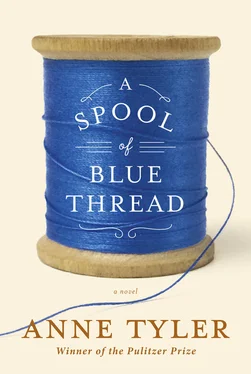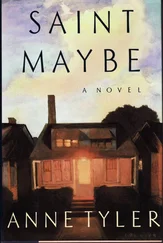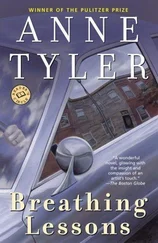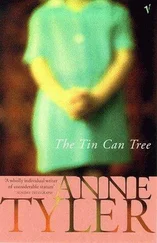Anne Tyler - A Spool of Blue Thread
Здесь есть возможность читать онлайн «Anne Tyler - A Spool of Blue Thread» весь текст электронной книги совершенно бесплатно (целиком полную версию без сокращений). В некоторых случаях можно слушать аудио, скачать через торрент в формате fb2 и присутствует краткое содержание. Год выпуска: 2015, Издательство: Bond Street Books, Жанр: Современная проза, на английском языке. Описание произведения, (предисловие) а так же отзывы посетителей доступны на портале библиотеки ЛибКат.
- Название:A Spool of Blue Thread
- Автор:
- Издательство:Bond Street Books
- Жанр:
- Год:2015
- ISBN:нет данных
- Рейтинг книги:3 / 5. Голосов: 1
-
Избранное:Добавить в избранное
- Отзывы:
-
Ваша оценка:
- 60
- 1
- 2
- 3
- 4
- 5
A Spool of Blue Thread: краткое содержание, описание и аннотация
Предлагаем к чтению аннотацию, описание, краткое содержание или предисловие (зависит от того, что написал сам автор книги «A Spool of Blue Thread»). Если вы не нашли необходимую информацию о книге — напишите в комментариях, мы постараемся отыскать её.
A Spool of Blue Thread — читать онлайн бесплатно полную книгу (весь текст) целиком
Ниже представлен текст книги, разбитый по страницам. Система сохранения места последней прочитанной страницы, позволяет с удобством читать онлайн бесплатно книгу «A Spool of Blue Thread», без необходимости каждый раз заново искать на чём Вы остановились. Поставьте закладку, и сможете в любой момент перейти на страницу, на которой закончили чтение.
Интервал:
Закладка:
Where he came from was never documented, but the general feeling was that he might have hailed from the Appalachian Mountains. Maybe he had once said something to that effect. Or it could have been mere guesswork, based on the way he talked. According to Abby, who had known him since her girlhood, he had a thin, metallic voice and a twangy Southern accent, although he must have decided at some point that it would elevate his social standing if he pronounced his i’ s in the Northern way. In the middle of his country-sounding drawl, Abby said, a distinct, sharp i would poke forth here and there like a brier. She didn’t sound entirely charmed by this trait.
Junior’s few photos revealed a face that was just a little too fine-boned — a look that people back then felt no compunction about referring to as “poor white trash.” In coloring he was pure Whitshank, black-haired even in his sixties with very white skin and squinty blue eyes, and he had the rangy, gaunt Whitshank body. He wore a stiff dark suit every day of the year, Abby said, but here Red would interrupt to say that the suits were a later development, when all Junior had to do was tour his work sites checking on things. Most of Red’s childhood memories featured his father in overalls.
At any rate, Junior’s first recorded appearance in Baltimore was as the employee of a building contractor named Clyde L. Ward. This came to light in a typewritten letter that was found among Junior’s papers after his death, telling Whom It May Concern that J. R. Whitshank had worked for Mr. Ward from June of 1926 through January 1930 and had proved an able carpenter. But he must have been more than merely able, because by 1934, a tiny rectangle in the Baltimore Post was advertising the services of Whitshank Construction Co., “Quality and Integrity.”
It was not the best era for starting a business, heaven knows, but apparently Junior flourished, first remodeling and then building from scratch various stately houses in the neighborhoods of Guilford, Roland Park, and Homeland. He acquired a Model B Ford pickup with an interlaced “WCC” painted on both doors above a telephone number — no mention of the company’s full name or its function, as if everyone who counted surely must know, by now. In 1934 he had eight employees; in 1935, twenty.
In 1936, he fell in love with a house.
No, first he must have fallen in love with his wife, because he was married by then. He had married Linnie Mae Inman at some point. But he never had much to say about Linnie, whereas he had a great deal to say, reams to say, about the house on Bouton Road.
It was nothing but an architect’s drawing the first time he laid eyes on it. Mr. Ernest Brill, a Baltimore textile manufacturer, had unfurled a roll of blueprints while standing in front of the lot where he and Junior had arranged to meet. And Junior glanced first at the lot (full of birds and tulip poplars and sprinkles of white dogwood) and then down at the drawing of the front elevation, which showed a clapboard house with a gigantic front porch, and the words that popped into his head were “Why, that’s my house!”
Not that he said this aloud, of course. “Hmm,” he said aloud. And “I see.” And he took the blueprints from Mr. Brill and studied the elevation. He turned to the sheets beneath to look at the floor plans. He said, “Mm-hmm.”
“What do you think?” Mr. Brill asked.
Junior said, “Well …”
It was not a grand house, of the sort that you might expect a man like Junior to covet. It was more, let’s say, a family house. A house you might see pictured on a thousand-piece jigsaw puzzle, plain-faced and comfortable, with the Stars and Stripes, perhaps, flying out front and a lemonade stand at the curb. Tall sash windows, a fieldstone chimney, a fanlight over the door. But best of all, that porch: that wonderful full-length porch. “It hit me,” was how Junior would put it later. “I don’t know; it just hit me.”
So he told Mr. Brill, “I reckon I could do it.”
Why hadn’t he simply built an identical house for himself? Red’s children used to ask. Copied the blueprints and built his own? Red told them he couldn’t say. Then he said that maybe it had had something to do with the site. Bouton Road was prime real estate, after all, and by 1936 most of the lots there had been bought up. In those days of no air conditioning, houses in Baltimore wore thick, dark awnings that shrouded the windows nearly to the sills from May to October of every year, but awnings wouldn’t be needed with all those tulip poplars. Besides, the way the house would occupy that particular property, perched at the top of a long, gentle slope: where else could it show so well?
So Junior built the house for Mr. Brill.
He built better than he’d ever built anything in his life. He niggled over every pantry shelf and cabinet knob. He argued against any request that struck him as cutting corners or lacking in good taste. Because taste, really, was the secret of Junior’s reputation. How he came by it nobody knew, but he had the most unerring nose for anything pretentious. No two-story columns for Junior! No la-di-da portes cochères, with their intimations of chauffeured limousines gliding up to let their passengers off! When Mr. Brill dared to broach the possibility of a U-shaped “carriageway” out front, Junior all but exploded. “Carriageway!” he said. “What in tarnation is that? You drive a Chrysler Airflow, not a coach-and-six!” (Or that was his report of the conversation, at least. He may very well have exaggerated his own outspokenness in the telling.) Then he went on to fantasize, at length and in loving detail, how visitors would approach the house. The driveway should run to the side, he said, for the sole use of the Brill family. Guests should park down on the street. Picture how they’d climb out of their cars, raise their eyes to the porch, start up the flagstone walk while Mr. and Mrs. Brill stood waiting on the porch steps to welcome them. Oh, and by the way, those steps should be wooden. It was wrong to have anything else. People thought of wooden steps as buckling or peeling, but when they were properly cared for there was nothing handsomer than a wide set of varnished treads (a bit of fine sand mixed into the varnish for traction) rising to a wooden porch floor as solid as a ship’s deck. Such steps took work, took money, took vigilance. Such steps signified .
Mr. Brill said he completely agreed.
Junior spent almost a year on the house, using all his men plus some he brought in from outside. Then the Brills took possession, and he went into mourning. Ordinarily a talker — his customers tried to avoid running into him when they had any place urgent to get to — he fell into a deep silence, and moped, and took little interest in the job that followed the Brills’ job. It was Junior himself who revealed all this, years later. (His wife was not very forthcoming.) “I just couldn’t believe,” he said, “that those folks got to live in my house.”
Luckily, it turned out that the Brills lacked handyman skills. When the first frost came, they telephoned Junior to say that the heat wasn’t working, and Junior had to drive over and bleed their radiators. He could have shown them how to do it themselves, but he didn’t. He went around to every room with a radiator key, and when he was finished he slipped the key back into his pocket and told the Brills to call him again if they had any more trouble. Pretty soon he was stopping by on a more or less weekly basis. The windows — outsized — required special screens and storm windows with finicky hardware, and he was the one who arrived spring and fall to supervise their installation. Like a love-struck groomsman who hangs around the bride long after the wedding, he kept inventing excuses to pop in. He dropped off a can of touch-up paint and then half a box of leftover floor tiles. He double-checked a lock that he had oiled just the week before. He came and went at all hours, using his own keys if nobody was home. Any telltale sign of wear he discovered sent him into a tizzy — a chip in the plaster or a hairline crack in a bathroom sink. He behaved as if he’d merely lent the house out and the borrowers were mistreating it.
Читать дальшеИнтервал:
Закладка:
Похожие книги на «A Spool of Blue Thread»
Представляем Вашему вниманию похожие книги на «A Spool of Blue Thread» списком для выбора. Мы отобрали схожую по названию и смыслу литературу в надежде предоставить читателям больше вариантов отыскать новые, интересные, ещё непрочитанные произведения.
Обсуждение, отзывы о книге «A Spool of Blue Thread» и просто собственные мнения читателей. Оставьте ваши комментарии, напишите, что Вы думаете о произведении, его смысле или главных героях. Укажите что конкретно понравилось, а что нет, и почему Вы так считаете.












